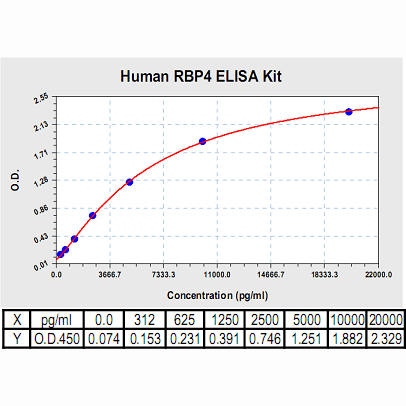Product Sheet CL0831
Description
BACKGROUND Retinol binding protein 4 (RBP4) expressed in adipocytes and liver, is an adipokine belonging to the lipocalin family and is involved in the transport of vitamin A/retinol.1 It delivers retinol from the liver stores to the peripheral tissues. In plasma, the RBP-retinol complex interacts with transthyretin, which prevents its loss by filtration through the kidney glomeruli. A deficiency of vitamin A blocks secretion of the binding protein posttranslationally and results in defective delivery and supply to the epidermal cells. Apart from its role as a retinol transporter, RBP4 has also been implicated in causing insulin resistance in muscle and liver. By impairing insulin signaling in muscle, RBP4 inhibits glucose uptake and interferes with insulin-mediated suppression of glucose production in the liver, causing blood glucose levels to rise. Conversely, mice lacking the RBP4 gene show increased insulin sensitivity, and normalizing increased RBP4 serum levels improves insulin resistance and glucose intolerance.2 Additionally several studies in various populations have reported elevated levels of RBP4 in type 2 diabetes and related metabolic parameters. It was shown that RBP4 modulates the activity of phosphoenol-pyruvate carboxy-kinase (PEPCK) in liver subsequently altering gluconeogenesis. In muscles, RBP4 alters the activation of Phophoinositide-3-kinase (PI3K) in response to insulin thus decreasing insulin stimulated glucose uptake into muscles. Furthermore, it was demonstrated that Stimulated by Retinoic Acid gene homolog 6 (STRA6) is the high affinity cell surface receptor for RBP4. STRA6 is a multi transmembrane domain protein that mediates the cellular uptake of vitamin A. In accordance with its role as the transmembrane transporter of vitamin A, STRA6 plays a major role in embryonic development. It was demonstrated that genetic variants in STRA6 are significantly associated with type 2 diabetes.3 cAMP pathway may play an important role in maintaining glucose metabolism homeostasis in vivo via upregulation of HMGA1 and RBP4.4
REFERENCES
1. Rask, L. et al: FEBS Lett. 104: 55–8, 1979
2. Yang, Q. et al: Nature 436: 356–62, 2005
3. Nair, A.K. et al: PLoS ONE 5:e11444, 2010
4. Chiefari, E. et al: BMC Biol. 7:24, 2009
2. Yang, Q. et al: Nature 436: 356–62, 2005
3. Nair, A.K. et al: PLoS ONE 5:e11444, 2010
4. Chiefari, E. et al: BMC Biol. 7:24, 2009
Products are for research use only. They are not intended for human, animal, or diagnostic applications.
Details
Cat.No.: | CL0831 |
Target Protein Species: | Human |
Range: | 312pg/ml-20,000pg/ml |
Specificity: | No detectable cross-reactivity with any other cytokine. |
Storage: | Store at 4°C. Use within 6 months. |
ELISA Kits are based on standard sandwich enzyme-linked immunosorbent assay technology. Freshly prepared standards, samples, and solutions are recommended for best results.
Products
| Product | Size | CAT.# | Price | Quantity |
|---|---|---|---|---|
| Human RBP4 ELISA Kit: Human Retinol Binding Protein 4 ELISA Kit | Size: 96 Wells | CAT.#: CL0831 | Price: $533.00 |

